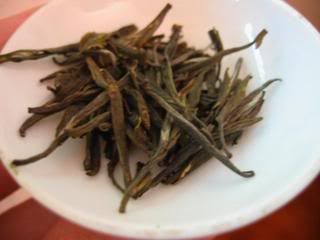I decided to try the Yun-Wu Meilan Chun first because it had an individual earthy, stone-like aroma, while reminiscent of a spice.


The name is quite confusing, "Yun-Wu" means "clouds and mist" indicating that it may have been grown at a high elevation where clouds create mist in the growing environment. "Meilan" could mean many different things, however "Mei Tsan" is the name of the tea plant this tea comes from, which is a slow-growing variety, often grown at a high-elevation, in a misty environment. After finding multiple different teas with the name Mei Lan to also be made up of tea from this Mei-Tsan plant, I believe this to be the defining connection. "Chun" means either springtime or precious, and with tea, springtime harvests often produce the best teas, so this tea is probably a spring harvest. In retrospect, this Yun-Wu Meilan Chun is from a slow-growing tea plant, grown in a high-elevation misty environment, and harvested in springtime.
As stated previously, the leaves have a particularly individual aroma for a green tea, smelling stone-earthy, while also relating to a stale, old cinnamon.



Loosely following the directions on the back of the tin, I steeped the tea in 175° water with a steep time of 3.5 minutes.

As the leaves became hydrated, it was clear that this tea was typically chinese in the sense that it was made up entirely of small, young leaves. From my experience I've found that the younger the leaves a tea is made up of, the less flavorful it becomes. This said, I was surprised when this tea was done.

The steeped leaves, while looking healthy, were all very young leaves, typical of a Chinese tea.

A pale yellow/green color:


While still having a more pale yellow/green liquor (typical of the less flavorful, young-leaved teas), the aroma that came from the tea was quite different from most greens I have experienced. This tea had a dominantly spice-like aroma, similar to cinnamon, maybe more of a roasted cinnamon. This part of the smell was quite pleasing, but also present was an undertone of a sweet lemon, almost peach-like in it's slight fruitiness.
When tasting the tea, it is sweet and elegant, another light chinese green. The spice is not as present in the taste of the tea as it is in the smell. The taste of spice is much lighter than it's smell, being lightly sweet with an almost mint taste to it. Investigating further, the sides of the tongue pick up a floral note that is slightly bitter at lower temperaturess. The floralness is similar to a dried out, sun-bleached weed-flower, not entirely pleasant.
The second steeping was identical in all aspects except taste.

The taste during the second steeping contained more of the spice, while having less of the fruity undertone. The spice flavor was accompanied by a very stray undertone of wheat.
In conlusion, the Yun-Wu Meilan Chun from Kasora Teas is a fairly good quality tea, being allowed to steep over three minutes without gaining any bitter taste. At over $15/oz I can say that it is a tea that is quite good, yet not one that I will be paying such a high price for. If offered, I would gladly accept a cup of such a tea, and I believe this sample will extinguish fairly quickly.


No comments:
Post a Comment